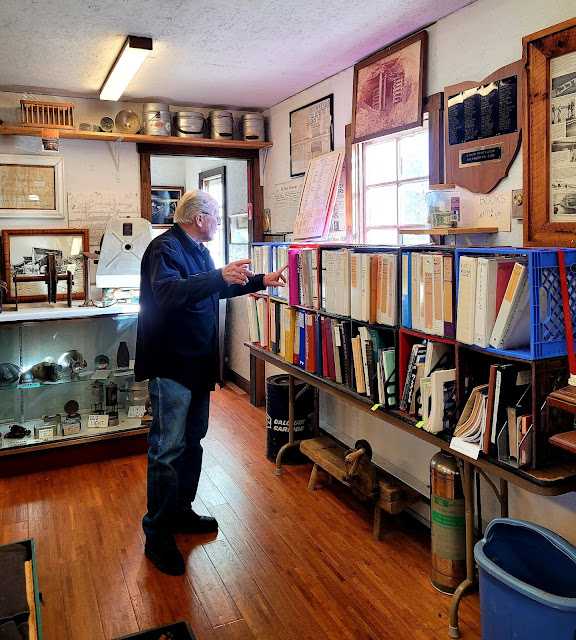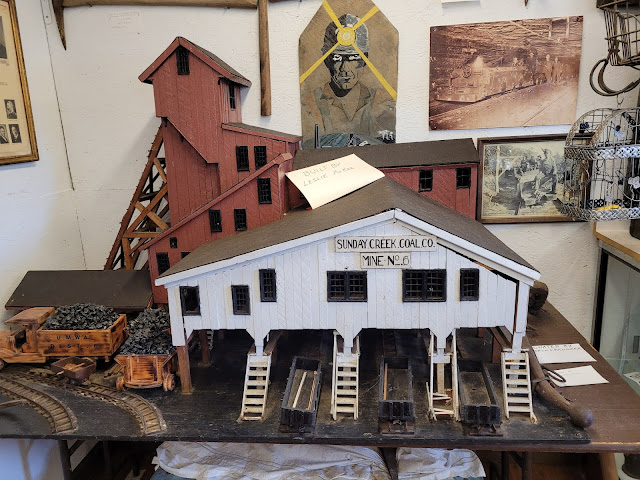 |
| Rodney Galentin at the Buchtel SE Ohio Mine Museum, November 2021 |
The road to Buchtel from
my house is short. It’s a road I’ve traveled often. Memories of my grandfather
and old friends surface. As a youth, I rode my horse through Buchtel many
times, usually stopping at the Watering Trough (an iconic watering hole with
old mine run-off) for a quick drink. But today I traveled to Buchtel to visit Rodney Galentin, an icon himself in the valley. Rodney is one of the
curators of the SE Ohio Mine Museum housed on Akron Avenue.
Buchtel used to be a mining boom town. The museum holds a well-kept collection of local history,
including exhibits that display the arduous work of long-ago citizens whose
relatives still roam the area. I talked with Rodney about the museum and the
importance of keeping history alive.
Rodney begins, “This building
used to be out at Hocking College, but they wanted to move it and they didn’t
know where to put it. Sunday Creek would have let them put it over where the old
mine stood, but I don’t know if you’ve ever been over there or not, it’s way
out in the country. Stuff wouldn’t have lasted very long if it had been put
there. I called Paul, he was one of the last members of the Millfield Mine, who
got the museum started. I told him I would talk with the village council to see
about land for the museum. Paul thought that would be great. To make a long
story short, we moved the museum here. Back in the 1900s there was a company
store here – on both sides of the road. The store burned twice in the early
1900s.
“Hocking College paid to
move the museum here. When we got it, there was no floor and no ceiling. The
Catholic Church and the Methodist Church gave us $500 each to restore the
building. It was all volunteer help. We had to buy the materials. People
donated artifacts and memorabilia for the displays. We have all the tools they
used inside the mines, some of the tools they used in the repair shops. Most of
the items came with the building, but we have no idea who donated some of it,
it was not labeled. We have newspaper articles and wooden structure replicas created
by locals. Now, I always note who donates items.
“We have mine rescue
equipment that they sent from Pennsylvania during the Millfield
Mine Disaster. The mine exploded and they did not have any rescue equipment
in the State of Ohio at that time. They put it on a train from Pennsylvania at
11 am. They say the engineer set a new track record to the Ohio line. The train
was here by 7 pm that same day.”
Walking through the museum
there are glass counters and walls of history. A birdcage with a fake canary
hangs among the memorabilia. Rodney continues, “The miners would carry a canary
in a cage into the mine. If the canary fell off the perch, you’d better get out
of there! They cut the canary’s claws so that when it died, it fell off the
perch. Otherwise, the canary would be dead on the perch. Here's a dinner
bucket, hats, and other things.”
There is a wall of
notebooks where newspaper articles, letters and photos are stored. Rodney has
them all labeled and organized by city, township, etc. Some of the cities are
no longer cities but hold memories for locals. “Younger people aren’t
interested. Just like their family tree – they’re not interested until they get
older, then everybody is dead who they could ask.”
We move forward, looking
through the glass cases with tiers of relics. On the floor is a large
rectangular case. “Carlos Brooker donated a first aid kit that they used in the
mines. It’s a Miner’s First Aid Station. Lots of people around here have given
us items. One of the Robinette ladies, the Robinette’s who had the hardware
store in Nelsonville, she gave us most of these old coins. They are scrip from
the company store. Everyone paid with scrip, not money. The only place you
could spend it was at the company store.”
On the wall above one of
the glass cases are two large lion heads. They seem to be old and, as my dad
would say, ‘…they’ve seen many a hard winter.’ Rodney explains, “Charlie
Townsend gave those to me. They used to be on the old show building down the
street. I have a picture of the building. They were hanging at the entrance.
There’s an old safe back here. It’s from Sayre’s store. Danny Sullivan gave it
to the museum. It was made in 1871. It weighs about 2,500 lbs. This section
over here is our school section. We have a lot of pictures and memorabilia from
the old schools before they were consolidated. Forty-eight schools
consolidated. Some of the towns are gone, like Cawthorne and Goose Run.”
There are many interesting
stories hidden in the museum. Some you wouldn’t believe except for the
newspaper article and photos that confirm the story. There are stones and
pieces of old buildings, photos of high schoolers, basketball teams, and yearbooks. Rodney holds a photo, “It’s always exciting when you know someone in
these pictures. Sometimes I get calls from people looking for genealogy
information.”
Stepping slightly to the
right, Rodney points to the corner. “Over here is our kitchen area. We have an old stove
and kitchen things. Some people will bring things in and just lay it on the table.
I don’t know where some of these things come from. There’s a written history of
the Ohio Valley that explains all of these things. You can get a
copy of it online. Here’s a picture of a local couple who became famous
country music stars. Uncle
Jack Nelson, who was born in Buchtel, began his radio career at WAIU in
Columbus.”
We look at more photos of
basketball, baseball, and football teams. “That was their only source of
entertainment – playing ball. I came in here one day and there was a box on the
table. I thought why in the Sam Hill would someone put their trash in here. Got
to looking and there was all kinds of old newspaper clippings and photos. I
have no idea who put it in here.”
Rodney used to be the
Buchtel Postmaster. I noticed a photo of one of my distant relatives, Lynn
LaFollette, on the glass counter. “Lynn used to be Postmaster, too. He was a
character. He came down to the house one day. He liked to drink coffee. I never
really liked coffee. I heated a cup of coffee and gave it to him. He took a
full tablespoon of instant coffee and put it right in his coffee. He lived
beside the ball diamond. He would give you anything. I told him one day my
refrigerator blew up. He said to take his. Within two or three days, he had another
refrigerator.”
Rodney’s passion for archiving
the past shines. “My great-grandpa George Washington Galentin worked in
the mine. He was from Longstreth. He worked in the Chauncey salt mines before
he moved to Longstreth. My grandpa John Galentin and my dad, George, worked
in the mine. They all lived in the same house. My great-grandpa Dixon never worked in the mine,
but my grandpa Bill Dixon worked in the Buchtel mine. Grandpa was a blacksmith.
One year in the 1930s, he was giving away coal from an abandoned mine for
Christmas. No one had anything back then. Everyone was glad to get the coal. It
was in the newspaper. But my grandpa Dixon was an artist by profession. He’d
paint on anything – even cardboard. I only know of two paintings that remain.
One is a summer scene and one is a winter scene. I got one of them.”
Nearing the end of the
tour, Rodney talks about his childhood. “One time, my cousin Lester Harris and
myself was walking down to Monday to watch TV at the Kinneers. It was in the
1950s and TV had just come out. Coming out of Longstreth where the brick church
is now, was a school. It was about dusk in the evening. There was a great big
hole in the roof of the school. We didn’t know what happened, we were just
kids. We walked over and told Ed Sanborn, he was a trustee at the time. We all
went over to the school. Ed must have had a key because we went inside. What
had happened, the hot water tank had a big copper coil that went through the
furnace and back to the tank. Someone forgot to turn the hot water valve off
and it built up pressure in the hot water tank. It was a big tank. It was about
six foot tall with one-inch pipes going through – a cold one and a hot one.
There was only about two feet between the top of the tank and the ceiling in
the basement. The pressure was so great, the tank flew up through the 2 x 10
ceiling joist, flooring, rafters, ceiling joist, and right on out through the
roof. There it sit, way down in the corner of the school lot. At the time I
didn’t think about how much pressure that would be, but it could’ve ended up on
the moon if it didn’t have such a hard time getting out of the building. Lucky
no one was hurt.”
Over an hour later, I
thank Rodney for his time and say I’ll be back another day. For a tiny museum
there is a lot to see. If you have a moment, contact Rodney for the grand tour.
You won’t regret it.


















No comments:
Post a Comment